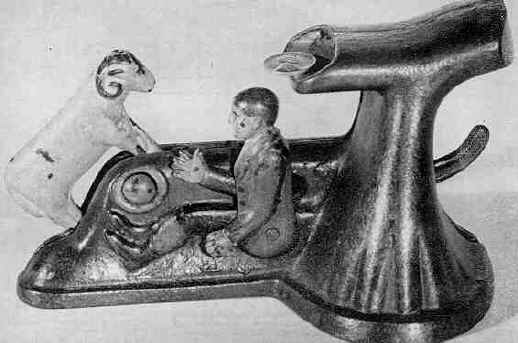Butting Ram Bank
by F.H. Griffith - HOBBIES Magazine - March, 1954

A small group of the mechanical banks employ the use of a goat or ram in connection with the coin being deposited in the bank. Among these we come to No. 27 in our numerical classification of the mechanical banks, namely the Butting Ram Bank.
The subject bank is often called the Bucking Ram, Bucking Goat, and various other names. However, the figure on the bank is a ram, not a goat and also he butts the tree. There is no action of bucking. The best accepted name, therefore, is the Butting Ram. Often to further identify the bank the terminology ‘Man Thumbs Nose’ is added. This can be included or not as the individual chooses, however it is not necessary as there is no other mechanical bank to date that employs a ram butting a tree.
The bank was designed and patented by Mr. O.O. Storle, of Burlington, Wisconsin, under Patent No. 548,672 dated October 29, 1895. Apparently this is the only bank patented by Mr. Storle. To the best of the writer’s knowledge the circumstances surrounding the place and name of the manufacturer is not known. The bank shown is in general good condition with no repairs and entirely original. It was obtained through the good help of Mr. E.L. Romey of Bluffton, Indiana.
It is painted in appropriate colors. The tree is an off-color brown and the base with its upright background is green. The boy’s shoes, trousers and hair are black. His hat is yellow and his coat light green. The ram is off-color white with black horns. The opening in the tree stump is yellow. Inscribed on the back of the bank is the following: Pat. Oct. 29, 1895. This is in the form of handwritten printing rather than the usual type of printing or lettering.
The bank operates as follows: First a coin is placed in the position as shown in the picture, at the opening in the tree stump. The lever located by the tree is then pressed and the ram butts forward knocking the coin into the bank with his head. At the same time the boy’s torso leans backward and he raises his right hand to his nose, thumbing his nose at the ram who had just missed him. The bank automatically resets itself for action upon releasing the lever.
There are several points of interest about this bank. One is that the writer has never seen a specimen in so-called mint paint condition. They all seem to have a varnish-type finish over the paint. The bank does not clean very well because of this. Another unusual feature is the fact that there is no way to properly remove the coins from the bank once they are deposited. The base bottom of the bank has a round type coin trap cast into the metal. However it is part of the base itself and cannot be removed. This is located under the tree stump and obviously it was meant to give the impression of being an actual operative coin trap. Another point is that the bank is riveted together so the only way coins can be removed is by shaking them out through the opening in the tree stump.
The number of Butting Ram Banks in private collections so far is very limited. A contributing factor to its rarity and desirability to a collector, of course, is the subject theme of the bank. There are three banks that employ the action of a figure thumbing his nose and this is the second one covered so far in the articles. The other two are the Freedman’s Bank and the Pelican.
